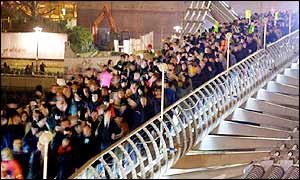개통식 후 3일만에 진동 문제로 폐쇄를 하고 대대적인 보강 후에 재개통한 Millennium Bridge의 원인은 수천명 군중들의 일정한 패턴의 발걸음이 야기시켰다는 그동안 알려진 바와는 다르게 160명 미만 사람들의 규칙적인 걸음으로 야기되었다는 코넬대학 Steve Strogatz 교수의 연구결과와 관련된 소식

Steve Strogatz has a penchant for things that happen in unison. So when the Cornell University professor of theoretical and applied mechanics (and author of the 2003 book “Sync: The Emerging Science of Spontaneous Order”) heard that thousands of pedestrians had caused London’s Millennium Bridge to rock from side to side on its opening day, he was intrigued.
Before the bridge across the River Thames opened, designers hailed it as “a pure expression of engineering structure.” They compared its sleek look to a blade of light. Engineers called it “an absolute statement of our capabilities at the beginning of the 21st century.”
But it’s what happened on opening day that is the subject of Strogatz’ Nov. 3 Nature paper.
The Millennium Bridge, a 320-meter-long lateral suspension bridge connecting London’s financial district to Bankside, south of the river, opened June 10, 2000. Thousands of pedestrians streamed over it.
At first, the bridge was still. Then it began to sway, just slightly.
Then, almost from one moment to the next, the wobble intensified. And suddenly, people were walking like tentative ice skaters: planting their feet wide, pushing out to the side with each step. Left, right, left, right, in near-perfect unison.
The synchrony was utterly unintentional. But it was those unchoreographed footfalls, says Strogatz, that were responsible for turning a $32 million design triumph into a very embarrassing engineering quandary. The bridge was closed almost immediately.
Strogatz, who has studied the collective behavior of biological oscillators from neurons to fireflies, describes each of the factors that contributed to the bridge’s swaying in his paper. Cornell graduate student Daniel Abrams is one of the paper’s co-authors.
The problem, says Strogatz, was one of crowd dynamics as much as engineering. The bridge surpassed standards for withstanding weight and wind. Every nonhuman element had been tested.
Instead of focusing on the structure, Strogatz examines the strange phenomenon of people unknowingly working together, simply by walking.
The military has known for years that troops marching in step can create enough vertical force to destroy a bridge. It is standard practice for soldiers to break step at every bridge crossing.
But the Millennium Bridge problem is not quite the same, says Strogatz. In this case, the movement was lateral, not vertical. More importantly, the people were just pedestrians. No one was trying to walk in step; pedestrians did so only to accommodate the bridge’s movement under their feet.
But which came first, the bridge’s movement or the synchronous strides? And what set the whole thing off?
“It’s a chicken-and-egg problem,” says Strogatz. “That’s what our paper explains.” From the beginning, the bridge had two factors working against it: It was by design a flexible structure, and its natural frequency is close to that of human walking. From there, Strogatz says, all it needed was a relatively small crowd to spark the wobble.
“If the people are initially disorganized and random, if a few of them get into sync by accident, the bridge would become unstable,” he says. With a certain critical number of pedestrians, the wobbling becomes marked enough to force everyone into stride — thus compounding the problem.
And the critical number of pedestrians, tested subsequently on the Millennium Bridge and derived independently by Strogatz and co-authors, is as low as 160. An estimated 80,000 people crossed the bridge on opening day, with as many as 2,000 on it at any one time.
“I’m not a civil engineer. I know nothing about bridges,” says Strogatz. “What I do know is group behavior. That was our contribution.”
The Millennium Bridge reopened in 2002 after engineers fitted it with 91 dampers to absorb both lateral and vertical oscillations. The modifications cost about $8.9 million.
If Strogatz’ analysis is correct — “and we hope someone will test it,” he says — engineers will be able to use it to prevent such expensive, embarrassing and possibly dangerous fiascos in the first place.
“They could solve the problem before they build it,” says Strogatz. “That’s what this theory will do.”
In addition to Abrams, the paper, “Crowd Synchrony on the Millennium Bridge,” was authored by Allan McRobie of the University of Cambridge; Bruno Eckhardt of Fachbereich Physik, Philipps-Universität, Marburg, Germany; and Edward Ott of the University of Maryland. Eckhardt and Ott solved the problem independently for the same result.
From Cornell University